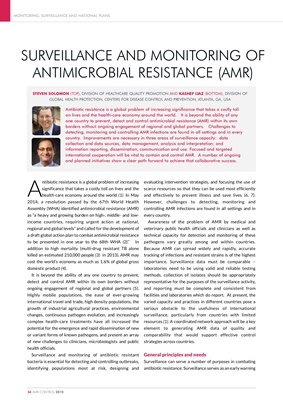
MONITORING, SURVEILLANCE AND NATIONAL PLANS
34 AMR CONTROL 2015
A
ntibiotic resistance is a global problem of increasing
significance that takes a costly toll on lives and the
health-care economy around the world (1). In May
2014, a resolution passed by the 67th World Health
Assembly (WHA) identified antimicrobial resistance (AMR)
as "a heavy and growing burden on high-, middle- and lowincome
countries, requiring urgent action at national,
regional and global levels" and called for the development of
a draft global action plan to combat antimicrobial resistance
to be presented in one year to the 68th WHA (2)." In
addition to high mortality (multi-drug resistant TB alone
killed an estimated 210,000 people (3) in 2013), AMR may
cost the world's economy as much as 1.6% of global gross
domestic product (4).
It is beyond the ability of any one country to prevent,
detect and control AMR within its own borders without
ongoing engagement of regional and global partners (5).
Highly mobile populations, the ease of ever-growing
international travel and trade, high density populations, the
growth of industrial agricultural practices, environmental
changes, continuous pathogen evolution, and increasingly
complex health-care treatments have all increased the
potential for the emergence and rapid dissemination of new
or variant forms of known pathogens, and present an array
of new challenges to clinicians, microbiologists and public
health officials.
Surveillance and monitoring of antibiotic resistant
bacteria is essential for detecting and controlling outbreaks,
identifying populations most at risk, designing and
evaluating intervention strategies, and focusing the use of
scarce resources so that they can be used most efficiently
and effectively to prevent illness and save lives (6, 7).
However, challenges to detecting, monitoring and
controlling AMR infections are found in all settings and in
every country.
Awareness of the problem of AMR by medical and
veterinary public health officials and clinicians as well as
technical capacity for detection and monitoring of these
pathogens vary greatly among and within countries.
Because AMR can spread widely and rapidly, accurate
tracking of infections and resistant strains is of the highest
importance. Surveillance data must be comparable -
laboratories need to be using valid and reliable testing
methods, collection of isolates should be appropriately
representative for the purposes of the surveillance activity,
and reporting must be complete and consistent from
facilities and laboratories which do report. At present, the
varied capacity and practices in different countries pose a
serious obstacle to the usefulness of international
surveillance, particularly from countries with limited
resources (1). A coordinated network approach will be a key
element to generating AMR data of quality and
comparability that would support effective control
strategies across countries.
General principles and needs
Surveillance can serve a number of purposes in combating
antibiotic resistance. Surveillance serves as an early warning
SURVEILLANCE AND MONITORING OF
ANTIMICROBIAL RESISTANCE (AMR)
STEVEN SOLOMON (TOP), DIVISION OF HEALTHCARE QUALITY PROMOTION AND KASHEF IJAZ (BOTTOM), DIVISION OF
GLOBAL HEALTH PROTECTION, CENTERS FOR DISEASE CONTROL AND PREVENTION, ATLANTA, GA, USA
Antibiotic resistance is a global problem of increasing significance that takes a costly toll
on lives and the health-care economy around the world. It is beyond the ability of any
one country to prevent, detect and control antimicrobial resistance (AMR) within its own
borders without ongoing engagement of regional and global partners. Challenges to
detecting, monitoring and controlling AMR infections are found in all settings and in every
country. Improvements are necessary in three areas of surveillance capacity: data
collection and data sources, data management, analysis and interpretation; and
information reporting, dissemination, communication and use. Focused and targeted
international cooperation will be vital to contain and control AMR. A number of ongoing
and planned initiatives show a clear path forward to achieve that collaborative success.